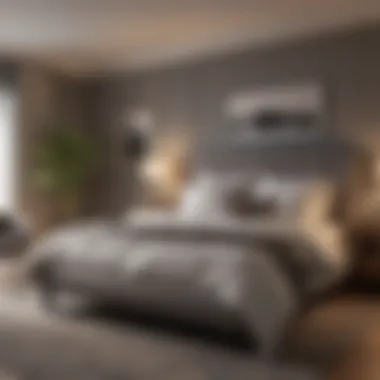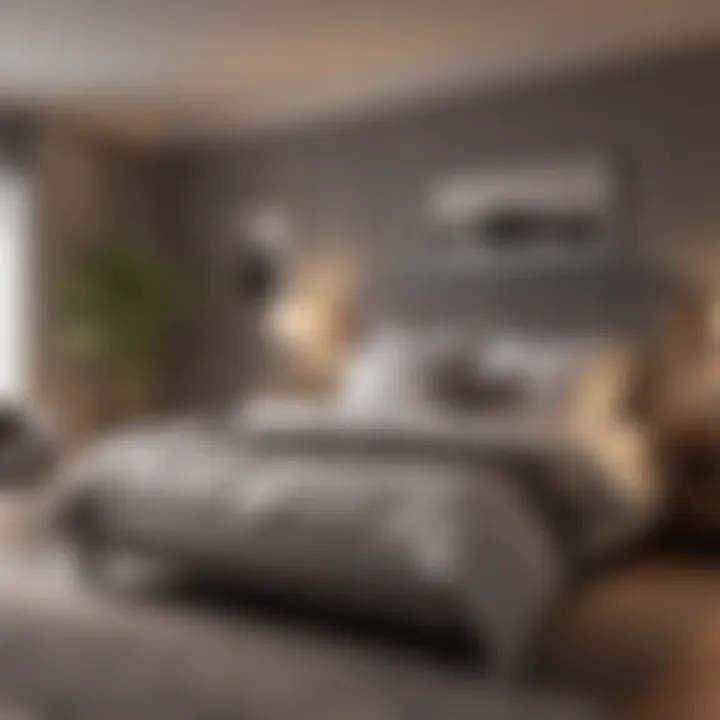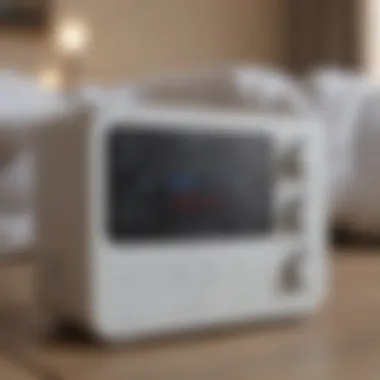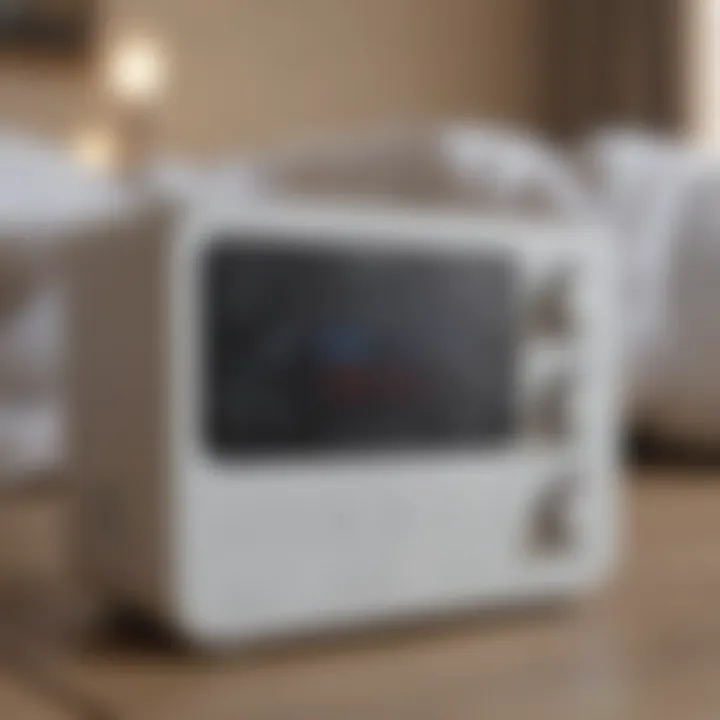Enhancing Sleep Quality with Nighttime Noise Makers


Well-Being Overview
Intro
Sleep quality is a cornerstone of overall well-being. It influences physical health, mental sharpness, and emotional resilience. Nighttime noise makers, commonly referred to as white noise machines or sound machines, play a significant role in creating an environment conducive to restful sleep. These devices can mask disruptive sounds, allowing individuals to drift off more easily and sleep more soundly.
Importance of Focusing on Sleep Quality
Quality sleep is often overlooked in discussions about health and well-being. In our fast-paced lives, we sometimes prioritize work or social activities over adequate rest. This neglect can lead to a range of negative outcomes, including increased stress levels, decreased productivity, and long-term health issues. Therefore, understanding how factors such as nighttime noise can impact sleep quality is paramount.
Integrating noise makers into a personalized sleep environment not only addresses external disturbances but also fosters a routine that encourages better rest. As health professionals and wellness coaches, recognizing these interconnections allows us to recommend avenues for optimizing patient or client experiences.
Mental Health Matters
Understanding Mental Health
Mental health encompasses emotional, psychological, and social well-being. It affects how we think, feel, and act. Quality sleep plays a crucial part in maintaining good mental health. Insufficient sleep can exacerbate mental health conditions such as anxiety and depression, often creating a vicious circle.
Strategies to Improve Mental Well-Being
Here are several strategies designed to enhance mental well-being through improved sleep:
- Implement a consistent sleep schedule.
- Utilize nighttime noise makers to create a steady auditory environment.
- Limit screen time before bed to minimize stimulation.
Coping Mechanisms for Stress and Anxiety
Reducing stress can significantly improve sleep quality. Activities such as meditation, exercise, and seeking therapy can serve as effective coping strategies. The integration of soothing sounds from nighttime noise makers can also aid in managing anxiety levels, allowing listeners to engage with their environment in a positive way.
Physical Wellness
Exercise Routines and Tips
Regular physical activity contributes to healthier sleep patterns. Engaging in different types of workouts can be tailored to individual preferences, whether it be strength training, yoga, or cardio. Incorporating sound machines into pre-exercise cool-downs can help transition the body into a restful state for better sleep.
Healthy Eating Habits
Nutritional choices impact sleep as well. Foods rich in magnesium or tryptophan, such as almonds and turkey, can support sleep hormones. Consider incorporating these into dinner routines to further enhance sleep quality.
Importance of Regular Physical Activity
A balanced approach to physical wellness promotes benefits across overall health, including better sleep outcomes. Regular exercise regulates sleep cycles and might decrease the reliance on sleep aids, including nighttime noise devices.
Mindfulness & Self-Care Practices
Exploring Mindfulness Techniques
Mindfulness emphasizes being present; it can invite calmness that contributes to more peaceful sleep. Techniques such as deep breathing or gentle stretching complemented by a sound machine can set the stage for rest.
Self-Care Rituals for Rejuvenation
Cultivating personal routines before bedtime can act as powerful cues that signal to the body it is time to wind down. For some, integrating a soothing audio backdrop can charm the transition to sleep.
Balancing Work and Relaxation
A defined boundary between work and relaxation enhances overall well-being. Sound machines can provide a welcoming atmosphere for relaxation, creating a buffer from the stresses encountered throughout the day.
Nutrition for Nourishment
Benefits of a Balanced Diet
Consuming a well-rounded diet not only supports overall health but can improve sleep outcomes. Nutritional balance is an essential component that connects physical wellness with improved sleep.


Nutrient-Rich Food Recommendations
Consider including these nutrient-dense foods into your diet:
- Leafy greens for magnesium.
- Fruit like bananas for potassium.
- Oily fish for omega-3 fatty acids.
Easy and Healthy Recipes to Try
Preparing a variety of quick and nutritious meals can be enjoyable. Simple recipes integrating wholesome ingredients, observed by a calming atmosphere created by noise machines, can foster a nourishing environment for both body and mind.
"A good night’s sleep can change everything from your mood to your cognitive functions. It is essential to prioritize rest in your daily routine."
By understanding and applying these principles, one can not only improve individual sleep quality but optimize their overall well-being.
Preamble to Nighttime Noise Makers
The necessity of understanding nighttime noise makers is tied closely to the quest for improved sleep quality, a growing concern in today’s fast-paced world. Sleep is a vital component of overall health and wellness. The right auditory environment significantly influences an individual's ability to relax and achieve restorative sleep. Nighttime noise makers offer a practical solution to some common sleep disorders, making them an integral part of modern sleep strategies.
Defining Nighttime Noise Makers
Nighttime noise makers are devices specifically designed to generate sound that can aid sleep. These can range from simple mechanical devices to complex smart systems that combine various sounds tailored to user preferences. White noise machines are among the most known types, producing constant sound profiles that mask or soothe disruptive noises. Other devices might incorporate nature sounds or gentle melodies, each providing different experiences to facilitate sleep. It is essential to understand their functionalities and the psychology behind how sound impacts sleep to appreciate their potential benefits fully.
Historical Context and Evolution
The concept of using sound to enhance sleep is not new. Historical records reveal that methods to create a conducive sound environment date back centuries. Ancient civilizations often used rhythmic drumming, chanting, or nature sounds to promote relaxation.
In the 20th century, the emergence of mechanical devices brought about a revolution in sleep aids. White noise machines gained popularity, especially among parents for their calming effects on infants. As technology advanced, these devices evolved significantly. Today, one can find smart noise makers connected to apps, capable of creating personalized soundscapes in response to individual preferences and needs. This progression illustrates a deeper recognition of the importance of auditory stimuli in achieving restful sleep.
Types of Nighttime Noise Makers
The exploration of nighttime noise makers is crucial in understanding their impact on sleep quality. Their types are varied, each offering unique benefits that cater to different sleep needs. By analyzing these categories, readers can make informed decisions on what best suits their personal sleep environment. The devices discussed here help to create a tailored sleep atmosphere, enhancing relaxation while minimizing disturbances, an essential factor for an optimal sleep experience.
White Noise Machines
White noise machines are among the most popular nighttime noise makers. They produce a consistent sound that masks other disruptive noises. This can be especially useful in urban environments, where outside sounds like traffic or sirens may disrupt sleep.
The function of white noise is simple. It creates a sound blanket that can help the brain relax. Studies have shown that individuals who sleep with white noise report a faster onset of sleep and improved overall sleep duration. The steady sound can also aid in maintaining sleep by preventing sudden disturbances from waking the sleeper. However, it is essential to select the right volume; too loud can be counterproductive, and too soft might not be effective.
Sound Machines with Nature Sounds
Sound machines that feature nature sounds are also gaining popularity as a means to enhance sleep quality. These devices simulate sounds such as rain, ocean waves, or a gentle breeze. For many, these sounds create a calming atmosphere that mimics a natural environment. This is helpful for reduction of anxiety and promoting relaxation.
Moreover, the psychological effects of nature sounds cannot be overlooked. People often associate these sounds with tranquility, which can promote deeper sleep. The variety in these sound choices allows users to select what resonates with them best. Individual preferences play a crucial role, so it is important to sample different soundscapes to find the most comforting options.
Smart Devices with Personalized Features
The advent of smart technology has introduced a new category of nighttime noise makers. Smart devices come equipped with personalized features that can adjust sounds based on user preferences. These may include options for sound combinations, volume control, and scheduling timers.
Customization is one of the significant advantages of smart devices. Users can create a more intimate sleep environment tailored to their specific needs. Some devices even integrate with sleep tracking technology, providing insights into sleep patterns and adjusting noise levels accordingly. This technological integration can foster a more responsive sleep ecosystem, ultimately leading to improved sleep quality. However, users need to ensure their devices do not introduce distractions that could hinder sleep.
"The choice of nighttime noise maker can be a crucial component in the pursuit of enhanced sleep quality. Each device serves a unique purpose and directly impacts user experience."
In summary, understanding the various types of nighttime noise makers, including white noise machines, sound machines with nature sounds, and smart devices, equips individuals with the knowledge to make informed decisions. This is key in crafting a supportive sleep environment vital for maintaining overall well-being.
Benefits of Using Noise Makers
Nighttime noise makers serve a vital role in promoting better sleep quality. Their presence can significantly enhance the overall sleep experience. It is essential to understand several specific benefits that noise makers provide to those struggling with sleep issues.
Improved Sleep Onset
The ability to fall asleep can often be hindered by various factors, including stress or intrusive thoughts. Noise makers create a consistent auditory background that helps mask these disruptive elements. By delivering a steady sound, they promote a feeling of safety and comfort. Research shows that individuals using white noise machines have a noticeable reduction in the time taken to fall asleep. The predictable nature of these sounds contributes to an easier transition into slumber. When selecting a noise maker, considering sounds that are gentle yet effective can lead to improved sleep quality.
Minimizing Sleep Disruptions


Frequent awakenings during the night can prevent restful sleep. Nighttime noise makers can significantly reduce these interruptions. They provide a barrier against sudden noises, such as traffic or household sounds. White noise, for instance, can help blend these external noises, making them less jarring. The use of sound machines can also enhance deep sleep cycles, allowing the body to recover fully. Users often report being able to sleep through noises that would have previously disturbed their rest. This aspect is crucial for those living in noisy environments or sharing spaces with others.
Enhanced Relaxation Techniques
Incorporating noise makers into a relaxation routine fosters an environment conducive to sleep. Many individuals benefit from pairing sound machines with relaxation techniques like meditation or deep breathing exercises. Sounds such as gentle rain or ocean waves can promote relaxation and aid in winding down before sleep. Establishing a routine that includes these practices, complemented by appropriate noise makers, creates a stronger psychological association with sleep. This can lead to consistent improvements in overall well-being.
"Utilizing nighttime noise makers can transform the sleep experience, providing both a buffer against external disturbances and a catalyst for relaxation."
Understanding how noise makers function and their psychological impacts emphasizes their importance. Personalized settings can further improve their effectiveness, ensuring users find the right balance that enhances their individual sleep experience.
Mechanisms of Action
Understanding how nighttime noise makers function is essential for grasping their impact on sleep quality. This section outlines the mechanisms through which sound affects sleep patterns and highlights the brain's responses to noise stimuli. These insights are valuable for those looking to implement effective strategies for better sleep.
How Sound Influences Sleep Patterns
Sound can play a significant role in how we fall asleep and the quality of our slumber. Various studies indicate that specific sound frequencies can aid in creating a conducive sleep environment. For instance, lower frequencies are often found to be more relaxing, helping to reduce stress levels.
- Falling Asleep: Gentle background noise helps signal to the brain that it is time to wind down. It can mask disruptive sounds, such as traffic or voices, facilitating a smoother transition into sleep.
- Sleep Cycle Regulation: Contrary to common belief, not all sounds disrupt sleep. Some noise patterns, when appropriately timed, can actually align with sleep cycles, encouraging deeper stages of restorative sleep.
- Brain's Reaction: Sounds can evoke emotional and cognitive responses which can either aid or hinder sleep onset. Therefore, the selection of background sound is crucial.
Through sound, individuals can customize their sleep environment, allowing them to journey into sleep more effortlessly.
Brain Response to Noise Stimuli
The brain’s engagement with noise stimuli significantly affects sleep quality. Research shows that the brain processes sound differently when we are asleep compared to when we are awake.
- Brain Waves: Different stages of sleep are associated with unique brain wave patterns. For instance, during deep sleep, the brain emits delta waves. The presence of steady, white noise may help reinforce these delta wave patterns, encouraging longer periods of deep sleep.
- Threat Response: The brain is always vigilant, even during sleep. Loud or jarring noises can trigger a heightened sense of awareness, leading to awakenings. Conversely, consistent noise can signal safety to the brain, reducing anxiety and promoting relaxation.
- Memory and Learning: Sleep is vital for memory consolidation. The right kind of background sound can potentially enhance the brain's ability to process and store memories.
Sound shapes our sleep experience in profound ways. Understanding this relationship offers opportunities to harness sound effectively to improve sleep quality.
Incorporating the right mechanisms of action through noise makers can lead to comprehensive strategies that enhance sleep quality. As such, a thoughtful approach to selecting and utilizing these devices is paramount.
Research and Evidence
Understanding the research and evidence surrounding nighttime noise makers is crucial for multiple audiences, including health professionals, wellness coaches, nutritionists, fitness trainers, and mindfulness instructors. This section aims to highlight the scientific backing of these devices and their effectiveness in enhancing sleep quality. Empirical studies detail various facets of how noise influences sleep and overall well-being. They also present findings that distinguish beneficial sounds from those that may disrupt it.
There lies significance in discernable research about the efficacy of nighttime noise makers. First, it provides a framework for evaluating the effectiveness of different product types. Second, it fuels ongoing discussions on best practices for individuals seeking better sleep solutions. Additionally, it encourages manufacturers to innovate and adapt devices based on user experience and established science.
Supporting evidence encompasses various methodologies, including laboratory studies, surveys, and controlled experiments. Such a range assures more robust findings regarding the impact of nighttime noise on sleep patterns. This section will explore specific studies and cases, aiding in a holistic understanding of how these devices can genuinely improve sleep quality.
Studies Supporting Efficacy
Research into the effects of nighttime noise makers typically identifies several key benefits. For example, studies often reveal that white noise can truncate environmental disturbances that might disrupt sleep onset or continuous sleep. One notable study from the University of Pennsylvania demonstrated that subjects using white noise machines experienced increased sleep duration compared to those without auditory stimuli. Psychological factors also play a role as certain sounds can elicit a calming response, promoting a state conducive to sleep.
Another significant aspect is sound frequency. Research indicates that lower frequencies often provide a more grounding effect, which aligns with deeper sleep stages.
Here are some key findings from various studies:
- White noise exposure reduced nighttime awakenings by nearly 30% in study participants.
- Participants reported a marked increase in sleep quality after just a week of using sound machines compared to a control group.
- Users familiar with nature sounds reported quicker sleep onset times.
Case Studies on User Experience
Real-life experiences further illustrate the role of nighttime noise makers in supporting better sleep quality. A noticeable trend appears in user narratives that underline personal adjustments to sleep hygiene. Such narratives showcase devices like the LectroFan or the Marpac Dohm. Users reported various outcomes, with many affirming that these machines became integral to their nightly routines.
"After using a sound machine for a month, I no longer dread falling asleep. The comforting noise dispatched my anxious thoughts, allowing me to relax," noted one user in a case study submitted to a wellness forum.
Some common themes emerged from user case studies:
- Customization: Users prefer devices that allow volume and sound selection adjustments.
- Comfort: Many find security in the consistent auditory background it provides, mimicking a womb-like environment.
- Sustainability: Those who are committed to long-term sleep improvement often integrate these noise makers permanently in their sleep routines.
By synthesizing both quantitative research and qualitative case studies, the evidence supports the assertion that nighttime noise makers effectively enhance sleep quality. This compendium of findings may assist health professionals and lifestyle coaches in guiding their clients towards better sleep practices.


Potential Drawbacks and Considerations
The use of nighttime noise makers holds promise for improving sleep, yet it is crucial to acknowledge the possible drawbacks and considerations. Understanding these aspects allows individuals to make informed decisions about their sleep environments.
Dependence on Noise Makers
One significant concern is the potential dependence on these devices. For some users, the habitual reliance on noise makers may develop over time. The brain can become accustomed to certain sounds as a sleep cue. While this can create a sense of security and aid in falling asleep, it can also lead to challenges should the device be unavailable. For instance, individuals traveling might struggle to sleep without their familiar background noise. Reports suggest that some individuals find themselves unable to sleep in silence. This over-reliance may cause anxiety surrounding sleep, knowing that the absence of noise might bring about difficulties in achieving rest.
Quality of Sounds and User Preferences
The quality of sounds produced by noise makers is another consideration. Not all noise machines are created equal. Users prefer various sound profiles, such as white noise, nature sounds, or even soft music. A poor-quality sound machine might produce irritating sounds that disrupt rather than enhance sleep. It is essential that users experiment with different types and settings to find what best suits their needs. Moreover, personal preferences play a vital role. What is soothing for one person may be distracting for another. The diverse range of sounds available requires careful choice to ensure effectiveness and user satisfaction.
"The effectiveness of sound as a sleep aid is not universal; it greatly depends on individual preferences and quality of sound composition."
In summary, while nighttime noise makers can greatly assist in enhancing sleep quality, understanding their potential drawbacks is essential for optimizing their use. A balance between the benefits and the considerations will assist in fostering an environment conducive to restful sleep.
Integrating Noise Makers into Sleep Routines
Integrating noise makers into sleep routines is crucial for enhancing overall sleep quality. By doing so, individuals can create a more conducive environment for rest, which can lead to significant benefits. The effective use of noise makers can not only improve how quickly one falls asleep but also help maintain a deeper sleep state throughout the night. Understanding how to incorporate these devices into daily routines aligns with personal sleep needs, making it a vital topic of discussion.
Creating a Personalized Environment
A personalized sleep environment is a key factor when utilizing nighttime noise makers. The device settings should align with individual preferences. For instance, some people may find the sound of gentle rain more soothing than constant white noise. By selecting the right type of sound, users can create a serene atmosphere that promotes relaxation.
- Here are some tips for creating such an environment:
- Choose the Right Sound: Experiment with different noises, such as ocean waves, forest sounds, or brown noise, to discover what works best for you.
- Utilize Positioning: Place the noise maker at an optimal distance from the bed. Too close might be overwhelming, while too far may render the sound ineffective.
- Control Lighting: Complement the auditory environment with proper lighting. Dimming the lights can enhance the effect of the noise maker, as soft lighting also signals to the brain that it's time to wind down.
Creating a tailored environment not only elevates the effectiveness of the noise maker but also provides a more enjoyable and restful experience.
Timing and Volume Considerations
Timing and volume are critical elements to consider when using noise makers. The timing of introducing sound into your sleep routine can either prepare the body for sleep or disrupt it. For most users, it's beneficial to start the noise maker at least 30 minutes before bedtime. This allows the body to adjust and creates a buffer for winding down.
Volume also plays a significant role. The sound should be loud enough to mask disruptive noises but not so loud that it becomes jarring. A general guideline is to keep sound levels at a soft background level, comparable to a quiet conversation.
"The right volume is essential; it should be a layer of comfort, not a source of anxiety."
Adjusting the volume based on personal comfort can enhance the sleeping experience, ensuring that noise makers serve their purpose effectively.
Alternatives and Complementary Practices
In exploring the role of nighttime noise makers, it is essential to also consider alternatives and complementary practices. These practices can significantly enhance the effectiveness of using noise makers, providing a more holistic approach to improving sleep quality. By integrating various techniques, individuals can craft a personalized sleep environment that caters to their unique needs and preferences. This section will address key alternatives, focusing on two prominent areas: meditation and mindfulness techniques and breathing exercises.
Meditation and Mindfulness Techniques
Meditation and mindfulness have gained recognition for their ability to reduce stress and promote relaxation. Integrating these practices into a bedtime routine can prepare the mind for restful sleep.
- Cultivating Presence: Practicing mindfulness encourages individuals to focus on the present moment. This can help alleviate anxiety about the day ahead or distractions from past events, thus promoting a more peaceful mindset before sleep.
- Guided Meditations: Many people find guided meditation particularly helpful. These sessions can be streamed through various apps or websites, often combining soft sounds or melodies that complement or replace noise from machines.
- Body Scan Techniques: One effective technique involves a systematic body scan. This method encourages individuals to focus on each body part, promoting relaxation and easing tension. As they progress through the scan, the awareness brings attention away from intrusive thoughts.
Breathing Exercises and Their Impact
Breathing exercises are straightforward but effective methods for managing stress and promoting relaxation. These techniques can enhance the efficacy of nighttime noise makers.
- Deep Breathing: Focusing on inhaling deeply and exhaling slowly can help lower heart rates and encourage relaxation. This is especially effective when combined with calming sounds.
- 4-7-8 Technique: This technique, developed by Dr. Andrew Weil, involves inhaling for a count of four, holding the breath for seven, and exhaling for a count of eight. It can help induce a state of calmness, making it easier to fall asleep.
- Progressive Relaxation: This method involves tightening and then relaxing different muscle groups sequentially. Pairing this with gentle noise can produce a tranquil environment, aiding in reducing physical tension.
Ultimately, integrating these alternative practices—meditation, mindfulness, and breathing exercises—into the bedtime routine can greatly benefit those using nighttime noise makers. By fostering a serene environment and establishing effective techniques for relaxation, individuals can cultivate a more restful sleep experience.
End and Future Directions
The discussion surrounding nighttime noise makers reflects a growing awareness of their potential benefits and limitations in enhancing sleep quality. It is imperative to recognize that these devices are not a one-size-fits-all solution. Personal preferences, underlying sleep disorders, and the overall sleep environment can significantly affect their efficacy. Understanding these nuances fosters a more informed approach for users seeking improved rest.
As we summarize the key insights from the previous sections, we note that nighttime noise makers, such as white noise machines and sound therapies, hold promise in offering a more restful sleep. Their capacity to mask disruptive sounds and create a soothing background can aid the transition into deeper sleep states. Further research continues to illuminate various aspects of how auditory stimuli, whether they are natural sounds or engineered noises, play a crucial role in sleep patterns.
Looking to the future, emerging trends in sleep technology show a promising direction that can further refine how noise makers serve individual needs. The integration of artificial intelligence and adaptive soundscapes into sleep devices holds potential for a more personalized experience. This aspect suggests a shift towards responsiveness, allowing ambient sounds to dynamically adjust based on user feedback or recorded data related to sleep stages.
Moreover, increasing awareness of sleep disorders highlights the necessity for tailored solutions in sleep hygiene practices. As more individuals seek holistic approaches to their well-being, nighttime noise makers will likely evolve alongside other wellness practices, such as mindfulness exercises and cognitive behavioral therapy.
In summary, the evolution of nighttime noise makers is not only about the advancement of technology but also about the interplay between user experience and scientific understanding of sleep. This evolving landscape will undoubtedly influence trends in health recommendations, paving the way for innovative solutions that prioritize sleep quality as a crucial element of overall health.



